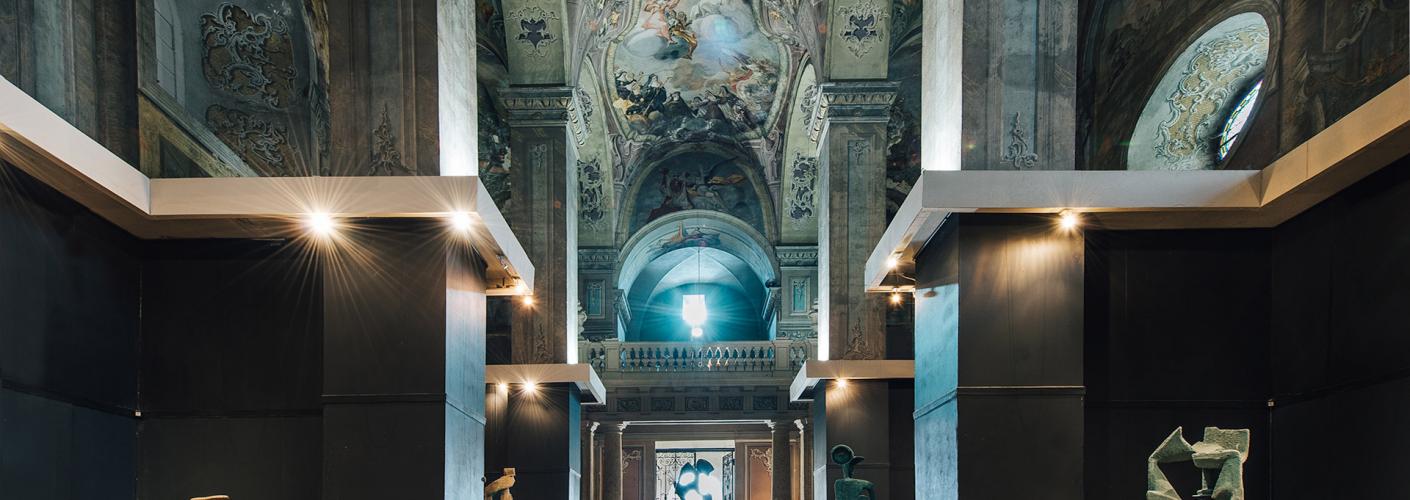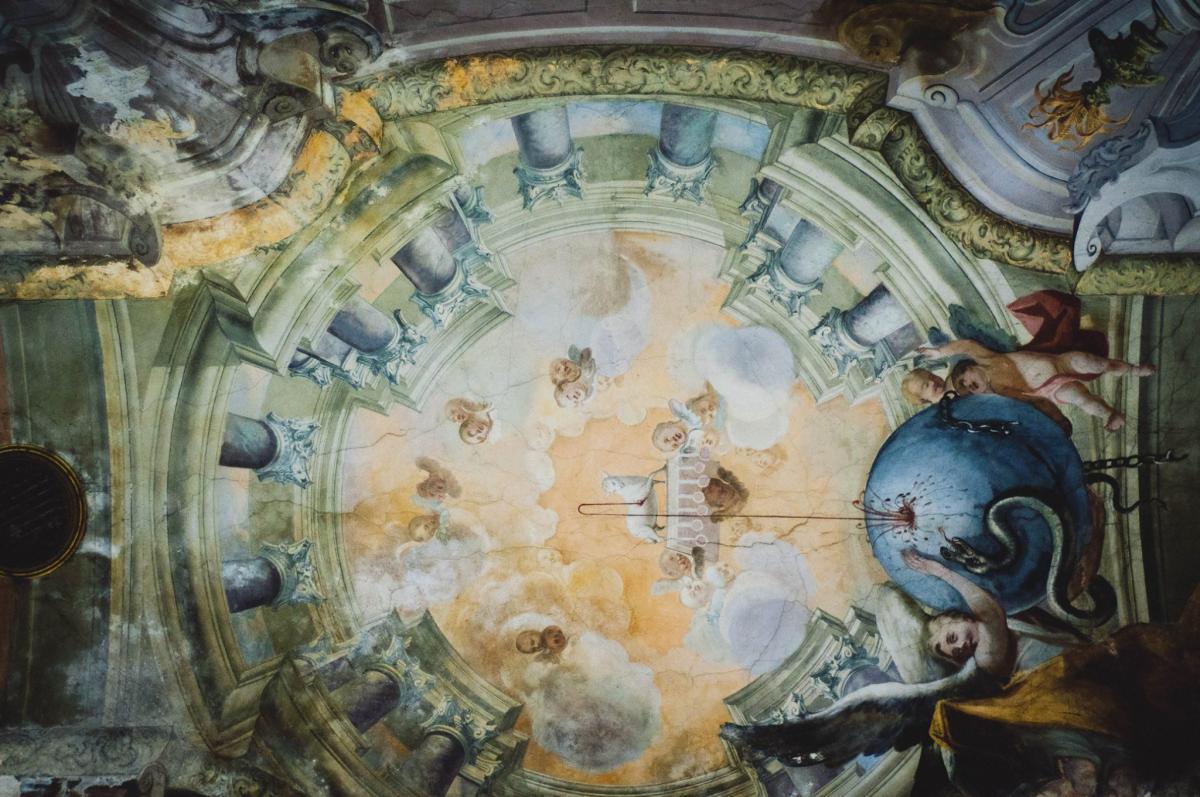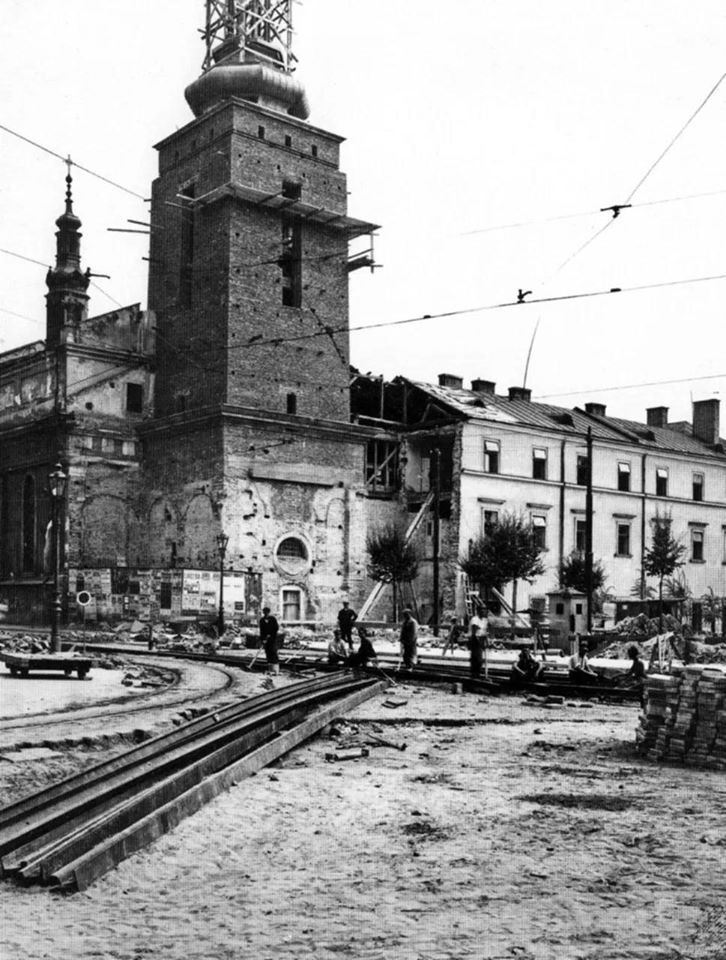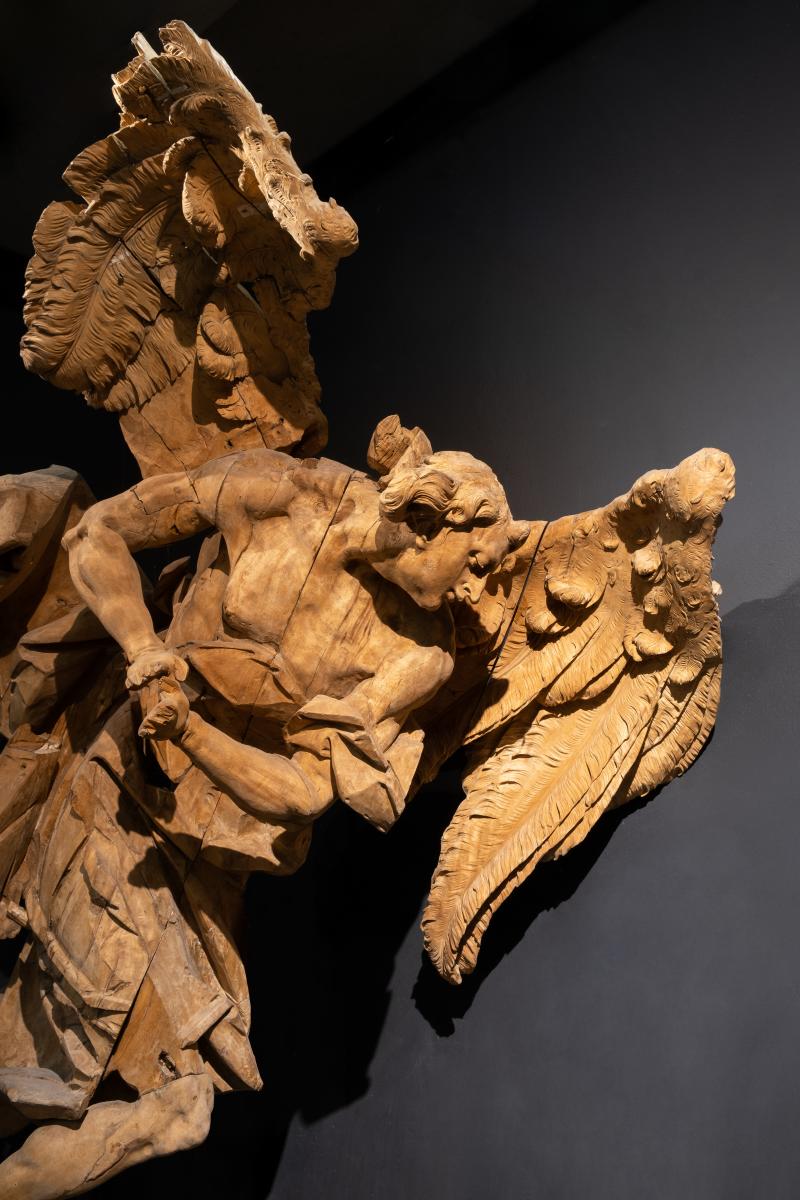
Інформація
Вартість вхідних квитків:
- для дорослих: 150 грн
- для дітей і пенсіонерів: 80 грн
- для студентів: 100 грн
Вартість сімейних квитків:
- 1 дорослий + 1 або 2 дитини: 250 грн
- 2 дорослих + 1 або 2 дитини: 400 грн
Вартість екскурсій для групи до 20 осіб:
- для дорослих: 400 грн
- для дітей і пенсіонерів: 200 грн
- для студентів: 300 грн
+38 032 275 69 66
+38 098 723 91 43
Музей Івана Георгія Пінзеля
Музей розташований у пам’ятці архітектури XVII ст. Скромний зовні і розкішно розписаний з середини Костел Кларисок споруджений у 1607 році Павлом Римлянином і Бернардом Авелідесом на місці каплиці св. Анни, монахинь кларисок бернардинського ордену. З тих часів збереглись ренесансні елементи бічного фасаду костелу від вулиці Личаківської.
У 1740-х костел зазнав реконструкції у бароковому стилі. В цей час розібрали вежу на західному фасаді й звели будівлю колишнього монастиря. Склепіння храму у 1760-х прикрасили розписи Станіслава Строїнського, хоча деякі дослідники вважають, що це робота його брата Мартина Строїнського. Окремі сюжети у південній наві намалював Тадеуш Попель на межі ХІХ-ХХ ст.

У зв'язку з пристосуванням храму під гарнізонний костел (1938–1939) його реконструювали за проектом архітектора Антонія Лобоса. Над чільним фасадом костелу добудовано вежу-дзвіницю у стилі функціоналізму з елементами бароко, реконструйовано будинок монастиря та впорядковано площу перед святинею.
Після касації монастиря Кларисок австрійським урядом в 1780-х у храмі розмістили склад тютюну, а в монастирі – митний уряд (цловий). Відтоді площа стала називатися Цловою – тепер Митною. Перед І світовою війною храм повернули віруючим, а в кінці 1940-х його знову пристосували під склад.
Ще на початку минулого століття костел відділяв від вулиці високий цегляний мур.
З 1978 приміщення костелу стали використовувати як виставковий зал сучасного мистецтва, а 1996 тут відкрили Музей барокової скульптури Іоана Георгія Пінзеля.

Майстер Пінзель, а в середині 1740-х років, коли він прибув до містечка Бучач на запрошення магната Миколи Потоцького – маловідомий майстер-сницар Іоан Георгій Пінзель. А його біографія й досі оповита багатьма таємницями.
Вирізьблені кам’яні фігури Бучацької ратуші принесли успіх молодому майстрові. Завдяки своєму надзвичайному художньому баченню скульптор починає отримувати багато нових замовлень. Він створює скульптури для святинь у Бучачі, Монастириськах, Городенці, Годовиці, Маріямполі, Львові, Рукомишлі, Буданові.

Пінзель зумів у кожний свій твір вкладати силу і легкість, темперамент і напругу, драматургію і перспективу смислів — проникливе розуміння людської душі. Однак його мистецький доробок чекав гідної уваги майже півтора століття. Лише у міжвоєнний період починається мистецтвознавче осмислення скульптурної спадщини Пінзеля, яке продовжується і тепер.
Внаслідок зневажливого ставлення до пам’яток сакральної архітектури на наших землях у другій половині ХХ століття велика кількість скульптур Пінзеля частково або повністю зникли. У Львівській національній галереї мистецтв зберігається найбільша кількість вирізьблених з дерева скульптур Майстра (у Музеї Пінзеля та Олеському замку), решта — в Івано-Франківську, Тернополі та Коломиї.
Більше про Івана Георгія Пінзеля та його творіння можна дізнатись за посиланням: https://pinsel-ar.com/
Прослухати аудіогід про Музей ви зможете за посиланням: https://podcasters.spotify.com/pod/show/megogo-audio9
Аудіогід Музеєм із аудіодискрипцією: https://podcasters.spotify.com/pod/show/megogo-audio51
Johann Georg Pinsel Museum
Johann Georg Pinsel Museum was opened in the premises of one of the oldest churches in Lviv, the Poor Сlares’ Church, in 1996. Now it is a branch of Borys Voznytskyi Lviv National Art Gallery. The former director of the Gallery, Borys Voznytskyi, together with the Gallery’s personnel worked on the creation of the museum and its exposition. A large part of the artistic heritage of Johann Georg Pinsel, Franciszek Oledzki, Maciej Polejowski, and other talented sculptors of the late Baroque period, who worked in our lands in the second half of the 18th century, was collected and saved from destruction during the expedition and rescue works of the 1960s and 1970s.
The Poor Clares’ Church is a national architectural landmark built between 1605 and 1607 by Paоlo Rоmаnus, an architect of Italian origin. Back then, the city of Lviv suffered from military conflicts that led to the destruction of its infrastructure. It was only in the middle of the 18th century that the city reconstruction began. During that time, new churches were built, while the existing ones were renovated. Thus, the Poor Clares’ Church acquired its new look. The results of its visual transformations were most evident in the elements of Baroque decoration. However, the main adornment of the church became interior frescoes created between 1760 and 1763 by Stanislaw Stroinski, a famous Lviv painter. Nowadays, the monumental paintings that embellish the walls and vaults of the church are nearly the only preserved works of the painter in Galicia. The last reconstruction of the sanctuary was carried out under the project of the architect Antoni Lobos at the beginning of the 20th century. As a result, a new bell tower appeared above the central facade upon completion of the work.
Combining the elements of several styles, namely Renaissance, Baroque, and Secession, today the Poor Clare’s Church serves as an excellent exhibition space for the sculptures by the brilliant and mysterious Johann Georg Pinsel. The exposition presents both early and late works of the artist, thereby showing the evolution of the master’s creative style. On display are also carvings from the Ternopil, Ivano-Frankivsk, and Lviv regions—the lands where the genius master worked—dating from the second half of the 1740s to the end of the 1750s.
The fate of the master's sculptures was complicated. Each has its own dramatic story, which one can learn more about at the museum. Johann Georg Pinsel’s masterpieces have been exhibited in Ukraine numerous times. The entire world admired them and still does. However, the current look of the sculptor’s works reminds us of the tragic history that left traces of barbarism on them.
The museum collection includes over 40 exhibits. Here are displayed not only the works by the master, his students, and followers but also the portraits of the sculptor’s patrons and clients.
In the autumn of 2021, Johann Georg Pinsel Museum became the first in Ukraine to be fully accessible to visitors with disabilities—visually impaired and blind people, as well as the ones with limited mobility, hearing impairments, and mental differences. At present, the permanent exposition is supplemented by a tactile display of eight sculptures made after the original master’s artworks. The scale photopolymer resin models were created by using 3D printing and 3D scanning technologies.
The museum offers its visitors a rare chance to plunge into the mystical world of the Baroque era, admire the illusionistic fresco paintings and portraits, and, most importantly, discover the unique works by Johann Georg Pinsel, which will impress you not only with their skillful execution but also with their incredible power of expression.
Muzeum Jana Jerzego Pinzla
Muzeum Jana Jerzego Pinzla mieści się w zabytku architektury z XVII wieku. Kościół Klarysek, skromny z zewnątrz i bogato pomalowany w środku, został zbudowany w 1607 roku przez Pawła Rzymianina i Bernarda Avellidesa na miejscu kaplicy św. Anny, dla Klarysek z Zakonu Bernardynek. Z tych czasów zachowały się elementy renesansowe bocznej elewacji kościoła od ulicy Łyczakowskiej.
W latach 40 XVIII wieku kościół przeszedł rekonstrukcję w stylu barokowym. Rozebrano wówczas wieżę w fasadzie zachodniej i wzniesiono budynek dawnego klasztoru. W latach 60 XVIII wieku sklepienia kościoła ozdobiono malowidłami Stanisława Stroińskiego, choć niektórzy badacze uważają, że jest to dzieło jego brata Marcina Stroińskiego. Osobne kompozycje w nawie południowej namalował na przełomie XIX i XX wieku Tadeusz Popiel.
W związku z przekształceniem świątyni na kościół garnizonowy (1938–1939) przebudowano go według projektu architekta Antoniego Łobosa. Nad główną fasadą kościoła dobudowano dzwonnicę w stylu funkcjonalizmu z elementami barokowymi, zrekonstruowano budynek klasztorny i urządzano plac przed sanktuarium.
Po kasacji klasztoru Klarysek przez rząd austriacki w latach 80 XVIII wieku w świątyni umieszczono skład tytoniu, a w klasztorze mieścił się urząd celny. Od tego czasu plac nosił nazwę Cłowy – obecnie Mytny. Przed I wojną światową świątynia została zwrócona wierzącym, a pod koniec lat 40 XX wieku świątynię ponownie zaadaptowano na skład.
Jeszcze na początku ubiegłego wieku kościół był oddzielony od ulicy wysokim ceglanym murem.
Od 1978 roku pomieszczenia kościelne zaczęto wykorzystywać jako salę wystawową sztuki współczesnej, a w 1996 roku otwarto tu Muzeum Rzeźby Barokowej Jana Jerzego Pinzla.
Mistrz Pinzel, a w połowie lat 40 XVIII wieku, kiedy on przybył na zaproszenie magnata Mikołaja Potockiego do miasta Buczacz, mało znany mistrz-snycerz Jan Jerzy Pinzel. A jego biografia wciąż owiana jest wieloma tajemnicami.
Rzeźbione kamienne figury ratusza w Buczaczu przyniosły sukces młodemu mistrzowi. Dzięki swojej niezwykłej wizji artystycznej rzeźbiarz zaczyna otrzymywać wiele nowych zleceń. Tworzy rzeźby dla świątyń w Buczaczu, Monasterzysku, Horodence, Hodowicy, Mariampolu, Lwowie, Rukomyszy, Budzanowie.
Pinzlowi udało się w każdym ze swoich dzieł włożyć siłę i lekkość, temperament i napięcie, dramatyzm i perspektywę znaczeń – przenikliwe zrozumienie ludzkiej duszy. Jednak jego dorobek artystyczny czekał na uwagę godną niemal półtora wieku. Dopiero w okresie międzywojennym rozpoczęła się artystyczna interpretacja rzeźbiarskiego dziedzictwa Pinzla, która trwa do dziś.
W wyniku pogardliwego stosunku do zabytków architektury sakralnej na naszych ziemiach w drugiej połowie XX wieku, duża część rzeźb Pinzla zniknęła częściowo lub całkowicie. Najwięcej rzeźb snycerskich Mistrza znajduje się we Lwowskiej Narodowej Galerii Sztuk Pięknych imienia B. Woznyckiego (w Muzeum Jana Jerzego Pinzla i na Zamku w Olesku), pozostałe – w Iwano-Frankiwsku, Tarnopolu i Kołomyi.
Więcej o Janie Jerzym Pinzlu i jego twórczości można dowiedzieć się pod linkiem: https://pinsel-ar.com/
Z audioprzewodnika o Muzeum można skorzystać pod linkiem: https://podcasters.spotify.com/pod/show/megogo-audio9
Audioprzewodnik po muzeum z audiodeskrypcją: https://podcasters.spotify.com/pod/show/megogo-audio51